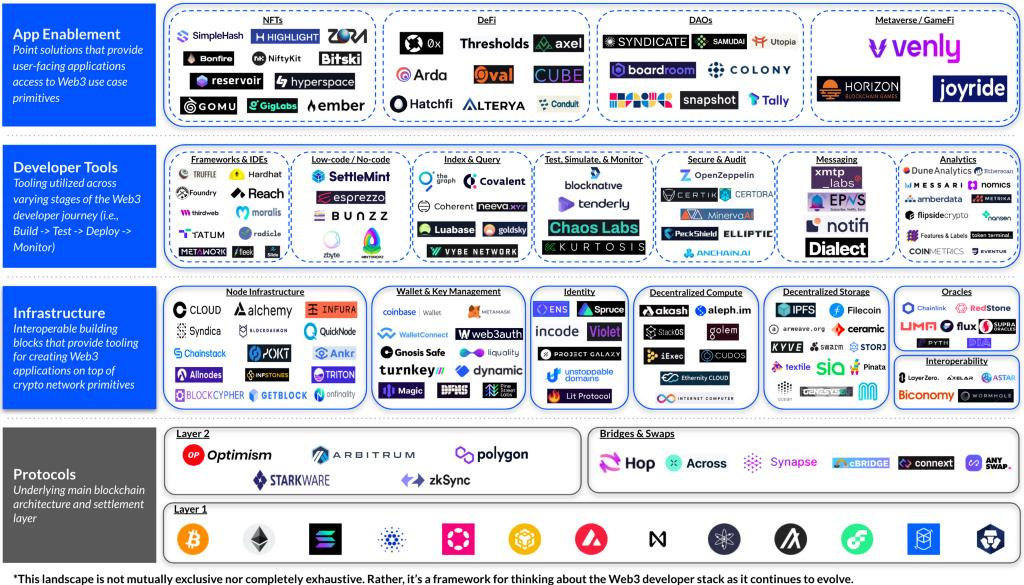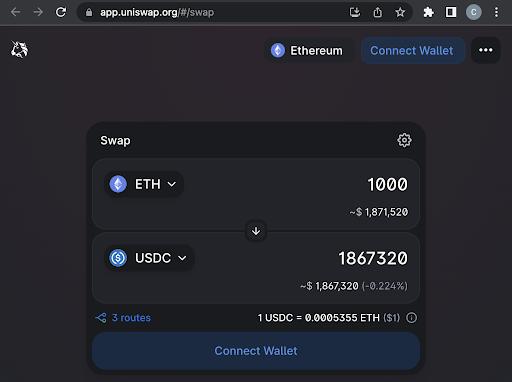การวิจัย Coinbase: คู่มือนักพัฒนาสำหรับ Web3 Stack
ผู้เขียนต้นฉบับ:Jonathan King, Connor Dempsey, & Hoolie Tejwani
ชื่อเรื่องเดิม: "A simple guide to the web3 developer stack》
ผู้เขียนต้นฉบับ:
ชื่อเรื่องเดิม: "
รวบรวมข้อความต้นฉบับ: Hu Tao, Chain Catcher
เหตุใดจึงมีนักพัฒนา web3 เพียงไม่กี่คนในปัจจุบัน ในแง่หนึ่ง เครื่องมือและโครงสร้างพื้นฐานที่มีให้สำหรับนักพัฒนา web3 นั้นแข็งแกร่งน้อยกว่า web2 มาก สิ่งนี้ทำให้การเริ่มต้นสร้าง ทดลอง และปรับใช้ใน web3 ยากขึ้น อย่างไรก็ตาม ทั้งหมดนี้เปลี่ยนแปลงอย่างรวดเร็ว เนื่องจากจำนวนนักพัฒนา web3 ที่ใช้งานรายเดือนพุ่งสูงสุดเป็นประวัติการณ์ในช่วงปลายปี 2021 เพื่อรองรับสถานการณ์ฉุกเฉินที่เพิ่มขึ้นนี้ ระบบนิเวศที่มีชีวิตชีวาของทีมกำลังทำงานเพื่อลดความซับซ้อนของเส้นทางนักพัฒนา web3 ทั้งหมด ท้ายที่สุดจะช่วยปลดล็อกระยะต่อไปของการเติบโตและนวัตกรรมของ web3
ชื่อระดับแรก

สแต็คนักพัฒนา Web3
ชื่อระดับแรก
สร้างขึ้นใน Web2 และ Web3
การพัฒนาซอฟต์แวร์เป็นกระบวนการสร้างโปรแกรมคอมพิวเตอร์ โปรแกรมที่กำหนดประกอบด้วยสามองค์ประกอบหลัก:
ส่วนหน้า (สิ่งที่ผู้ใช้โต้ตอบด้วย)
แบ็กเอนด์ (ที่ผู้ใช้มองไม่เห็น)

ฐานข้อมูล (ที่เก็บข้อมูลสำคัญ)
ฟรอนต์เอนด์ที่ผู้ใช้ทั่วไปโต้ตอบผ่านเบราว์เซอร์มือถือหรือเดสก์ท็อปโดยพื้นฐานแล้วจะเหมือนกันใน web2 และ web3 แอปพลิเคชัน web3 เช่น Uniswap นั้นดูคล้ายกับแอปพลิเคชัน web2 ทั่วไป เนื่องจากส่วนหน้าทั้งสองส่วนใหญ่สร้างขึ้นโดยใช้ React ซึ่งเป็นเฟรมเวิร์กยอดนิยมสำหรับนักพัฒนาเว็บและแอปพลิเคชันมือถือ
นี่คือจุดที่ web2 และ web3 แตกต่างกัน เฟรมเวิร์กแบ็กเอนด์และประเภทฐานข้อมูลที่ทำให้คุณสมบัติการกำหนดของ web3 (ความเป็นเจ้าของที่กำหนดโดยผู้ใช้) เป็นไปได้นั้นใหม่และไม่ซ้ำใคร
แอปพลิเคชัน web2 พึ่งพาฐานข้อมูลส่วนกลางอย่างมาก ในขณะที่แอปพลิเคชัน web3 สร้างขึ้นบนฐานข้อมูลแบบกระจายศูนย์ (บล็อกเชน) สิ่งนี้ต้องการแบ็กเอนด์ใหม่ทั้งหมดและองค์ประกอบพื้นฐานใหม่ เช่น กระเป๋าเงิน
มาดูแบบทีละชั้น (โดยสังเขป) ที่กลุ่มผู้พัฒนา Web3 ที่กำลังพัฒนา (* หมายถึงบริษัทในพอร์ตโฟลิโอของ Coinbase Ventures)
ชั้นโปรโตคอล

ชื่อเรื่องรอง
ชั้นโปรโตคอลOptimism*、 Arbitrumการตัดสินใจครั้งแรกที่นักพัฒนา web3 ต้องทำคือโปรโตคอลบล็อกเชนที่จะใช้เป็นฐาน การสร้างบน Bitcoin นั้นแตกต่างอย่างสิ้นเชิงกับการสร้างบน Ethereum และการสร้างบน Solana นั้นไม่เหมือนกับการสร้างบน EthereumHop*สำหรับแอปพลิเคชันที่เร็วกว่าและต้นทุนต่ำกว่า นักพัฒนาอาจต้องการใช้ฐานของพวกเขาSynapse* และโปรโตคอลชั้นที่สองอื่น ๆ สำหรับแอปพลิเคชันที่ต้องการถ่ายโอนมูลค่าจากเครือข่ายหนึ่งไปยังอีกเครือข่ายหนึ่ง นักพัฒนาจะต้องใช้ประโยชน์จาก
* รอข้ามสะพานโซ่.
เมื่อทำการตัดสินใจเหล่านี้แล้ว นักพัฒนาสามารถเริ่มประกอบแบบเอกสารสำเร็จรูปที่ทำให้แอปพลิเคชันของผู้ใช้เป็นไปได้

ชื่อเรื่องรอง
โครงสร้างพื้นฐานดั้งเดิมสิ่งต่อไปที่นักพัฒนาจำเป็นต้องทราบก็คือ ในที่สุดแล้วแอปพลิเคชันของพวกเขาจะโต้ตอบกับบล็อกเชนพื้นฐานได้อย่างไร นี่คือที่มาของโครงสร้างพื้นฐานดั้งเดิมCoinbase Cloud、 Infuraโครงสร้างพื้นฐานของโหนดAlchemy- โหนดเป็นที่ที่แอปพลิเคชันโต้ตอบกับ blockchain "เกิดขึ้น" เป็นคอมพิวเตอร์ที่อ่านสถานะของบล็อกเชนและเขียนอัปเดตเมื่อผู้ใช้โต้ตอบกับแอปพลิเคชัน
* และผู้ให้บริการโครงสร้างพื้นฐานของโหนด เช่น * ทำให้นักพัฒนาสามารถตั้งค่า จัดการ หรือเข้าถึงโหนดบล็อกเชนได้ง่าย ซึ่งช่วยประหยัดเวลาและทรัพยากรของนักพัฒนาได้มากCoinbase Walletการจัดการกระเป๋าเงินและกุญแจWeb3Auth—— กระเป๋าเงิน Blockchain เช่นPine Street Labs* หรือ
ตัวตน* ผู้ให้บริการ Wallet และการจัดการคีย์ เช่น * ช่วยให้นักพัฒนาสามารถสร้างการเชื่อมต่อที่ปลอดภัยระหว่างกระเป๋าเงิน blockchain และแอปพลิเคชันที่ผู้ใช้เห็นENSตัวตนSpruce--รูปภาพLit Protocol* โปรโตคอลดังกล่าวทำหน้าที่เป็นตัวตนของผู้ใช้ในแอปพลิเคชัน
* จัดเตรียมเฟรมเวิร์กและชุดเครื่องมือที่นักพัฒนาสามารถใช้เพื่อตรวจสอบความถูกต้องของข้อมูลรับรองผู้ใช้เพื่อรับรองความถูกต้องของการดำเนินการบน Ethereum ตัวอย่างเช่น นักพัฒนาสามารถใช้ชุดเครื่องมือ Spruce ID เพื่ออนุญาตให้ผู้ใช้เข้าสู่ระบบ dApps โดยใช้บัญชี ENS ของตน นอกจากนี้ยังชอบการคำนวณแบบกระจายอำนาจAkash NetworkและAleph.im- ทรัพยากรคอมพิวเตอร์ให้พลังการประมวลผลที่แอปพลิเคชันใช้ในการทำงานด้านคอมพิวเตอร์ ปัจจุบัน การประมวลผลเครือข่ายส่วนใหญ่ให้บริการโดยผู้ให้บริการแบบรวมศูนย์ เช่น AWS การประมวลผลแบบกระจายอำนาจคือการเปลี่ยนไปใช้เครือข่ายของชุมชนที่ทรัพยากรการประมวลผลถูกแจกจ่ายในลักษณะที่ต้นทุนต่ำและไม่มีการอนุญาต
และโครงการต่างๆ เช่น ได้เกิดขึ้นแล้ว โดยนำเสนอทรัพยากรการประมวลผลแบบ peer-to-peer ที่มีประสิทธิภาพสูง ปรับให้เหมาะสมสำหรับสัญญาอัจฉริยะและแอปพลิเคชันบล็อกเชนIPFS、 Arweaveการจัดเก็บข้อมูลแบบกระจายอำนาจCeramic Network* และ
ออราเคิลออราเคิลChainlinkหรือFluxหรือ
การทำงานร่วมกัน* เมื่อออราเคิลเข้ามา ให้เชื่อมต่อบล็อกเชนกับแหล่งข้อมูลทั้งแบบออนเชนและออฟเชนLayerZeroการทำงานร่วมกันAstar Network* โปรโตคอลการทำงานร่วมกัน เช่น * ช่วยให้นักพัฒนามี SDK และ API เพื่อสร้าง dApps ที่พกพาได้และสามารถสื่อสารกับบล็อกเชนต่างๆ ได้
เครื่องมือสำหรับนักพัฒนา

ชื่อเรื่องรอง
เครื่องมือสำหรับนักพัฒนากรอบงานและ IDETruffle、 Moralis *、 TatumและThirdWebและFoundryและHardHatเฟรมเวิร์ก Web3 เช่น * ช่วยให้นักพัฒนาใช้ประโยชน์จากโค้ดที่มีอยู่สำหรับแอปพลิเคชันสัญญาอัจฉริยะ ดังนั้นพวกเขาจึงไม่ต้องสร้างทุกอย่างตั้งแต่เริ่มต้น พวกเขายังอนุญาตให้นักพัฒนาทดสอบและปรับใช้แอปพลิเคชัน
และสภาพแวดล้อมการพัฒนาแบบรวม (IDE) เช่น IDE รวมโปรแกรมแก้ไขซอร์สโค้ดทั่วไปและสร้างเครื่องมือการทำงานอัตโนมัติและการดีบักไว้ในอินเทอร์เฟซเดียวที่เข้าถึงได้ง่ายSettlemint- แพลตฟอร์มเหล่านี้ช่วยให้สามารถออกแบบ/ปรับใช้แอปพลิเคชันที่ผู้ใช้เผชิญหน้าได้อย่างรวดเร็วผ่านอินเทอร์เฟซแบบลากแล้วปล่อย รูปภาพ
การทำดัชนีและการสอบถามบริษัทดังกล่าวจัดหาเทมเพลต NFT smart contract ให้กับนักพัฒนาเพื่อป้องกันไม่ให้นักพัฒนา web3 ต้องคิดค้นนวัตกรรมใหม่Graph Protocol *、 CovalentการทำดัชนีและการสอบถามCoherent- ตัวสร้างดัชนีข้อมูลช่วยให้ผู้คนค้นหาและเข้าถึงข้อมูลเฉพาะในฐานข้อมูลพื้นฐาน ใน Web2 นั้น Google Search เป็นบริการจัดทำดัชนีข้อมูลที่ได้รับความนิยมสูงสุด ซึ่งช่วยให้ผู้ใช้สามารถสืบค้นข้อมูลที่จัดเก็บไว้ในฐานข้อมูลออนไลน์ด้วยเวลาตอบสนองที่สั้นลงเป็นวินาที ใน Web3 บริการจัดทำดัชนีแบบกระจายกำลังเกิดขึ้นเพื่อช่วยให้นักพัฒนา dApp ได้รับ ประมวลผล และสืบค้นข้อมูลบล็อกเชน
* และ* ทั้งคู่มี API สำหรับการดึงและใช้ข้อมูลจากผู้ให้บริการพื้นที่จัดเก็บข้อมูลแบบกระจายศูนย์และบล็อกเชนที่เข้ากันได้กับ EVMTenderlyทดสอบ จำลอง และตรวจสอบKurtosis- สิ่งสำคัญคือต้องทดสอบและจำลองแอปพลิเคชัน web3 ก่อนที่จะเผยแพร่ รูปภาพBlocknative* และ
* บริษัทดังกล่าวมีเครื่องมือต่างๆ เพื่อจำลองสัญญาอัจฉริยะและธุรกรรม รวมถึงเครื่องมือในการแก้ปัญหาต่างๆ* จัดเตรียมแดชบอร์ดและเครื่องมือสำหรับตรวจสอบธุรกรรมก่อนที่จะผูกมัดกับห่วงโซ่OpenZeppelin *、 CertikความปลอดภัยและการตรวจสอบCertora- ด้วยศักยภาพในการใช้ประโยชน์จากสัญญาอัจฉริยะ แพลตฟอร์มเหล่านี้จึงช่วยให้นักพัฒนาสามารถใช้แนวทางปฏิบัติด้านความปลอดภัยและการตรวจสอบที่ดีที่สุดกับแอปพลิเคชันของตนได้
* และ* ทั้งคู่ให้บริการ เฟรมเวิร์ก และเครื่องมือตรวจสอบที่หลากหลายแก่นักพัฒนาเพื่อลดความเสี่ยงด้านความปลอดภัยที่อาจเกิดขึ้นและช่องโหว่XMTP Labsส่งข้อความEPNS* และ
วิเคราะห์บริษัทต่างๆ เช่น Web3 กำลังสร้างโปรโตคอลการส่งข้อความที่ปลอดภัยและเครือข่ายการสื่อสารแบบกระจายอำนาจเพื่อผลักดันการมีส่วนร่วมของผู้ใช้และขับเคลื่อนการแจ้งเตือนเหล่านี้ในแอปพลิเคชัน Web3Dune *、 Nansenวิเคราะห์Messari- มีแพลตฟอร์มและบริการมากมายที่ช่วยให้นักพัฒนาสำรวจ วิเคราะห์ ดึงข้อมูลและแสดงภาพข้อมูลบล็อกเชนFlipside Crypto* จัดเตรียม SDK (Software Development Kit) และ API เพื่อสร้างและแบ่งปันข้อมูลเชิงลึกเกี่ยวกับโครงการ crypto ต่างๆ
ชั้นสนับสนุนแอปพลิเคชัน

ชื่อเรื่องรอง
ชั้นสนับสนุนแอปพลิเคชันSyndicate *、Samudaiเลเยอร์การสนับสนุนแอปพลิเคชันเชื่อมโยงเลเยอร์ด้านบนทั้งหมดกับการใช้งาน web3 เฉพาะ NFTs, DAO, DeFi และเกมล้วนมีโซลูชันสำหรับนักพัฒนาที่ปรับแต่งเองSnapshotเครื่องมือที่เน้น NFT เป็นโครงสร้างพื้นฐานสำหรับการสร้างและจัดการสินทรัพย์ NFT เครื่องมือ DAO สร้างสำหรับ DAO (Utopia Labs*), การกำกับดูแล (Venly *、Joyride *、 Horizon Blockchain Games*) ให้การแก้ปัญหา เครื่องมือที่เน้น DeFi มี API ที่ช่วยให้นักพัฒนาเข้าถึง DeFi ดั้งเดิมต่างๆ ได้ เครื่องมือที่เน้นเกม (
*) ให้บริการโซลูชั่นสำหรับการสร้างโลกเสมือนจริงและเกมที่ใช้บล็อคเชน
ชื่อระดับแรก
สแต็คการพัฒนาที่พัฒนาอย่างต่อเนื่อง
โปรโตคอล โครงสร้างพื้นฐาน และเครื่องมือสำหรับนักพัฒนาที่กล่าวถึงข้างต้นประกอบขึ้นเป็นกลุ่มนักพัฒนา web3 ที่เพิ่งตั้งไข่แต่กำลังเติบโต โมดูลาร์และความสามารถในการทำงานร่วมกันของ web3 หมายความว่าสแต็คสามารถรวมกันได้ไม่รู้จบเพื่อสร้างแอปพลิเคชันใหม่และน่าสนใจ



